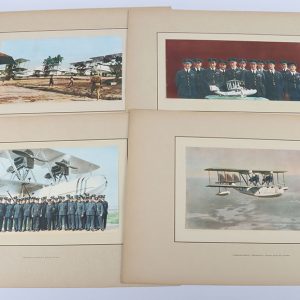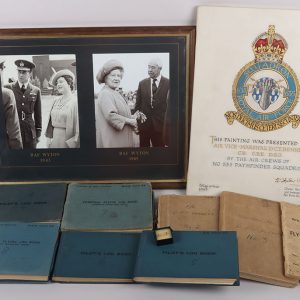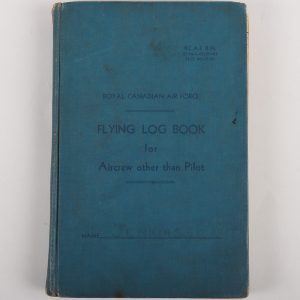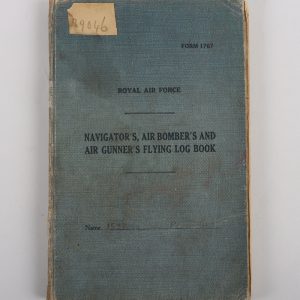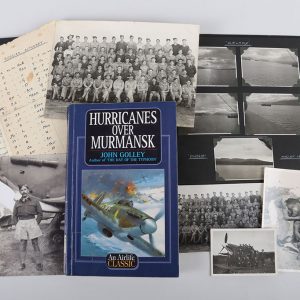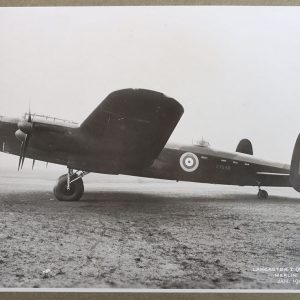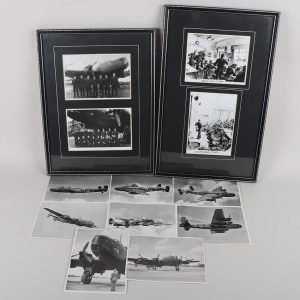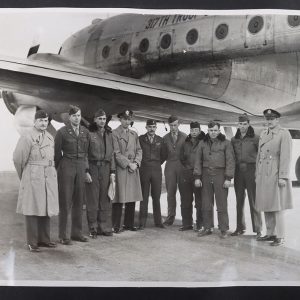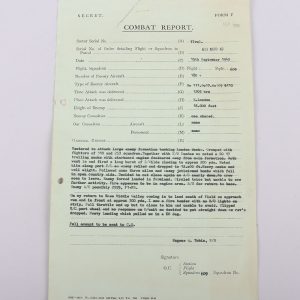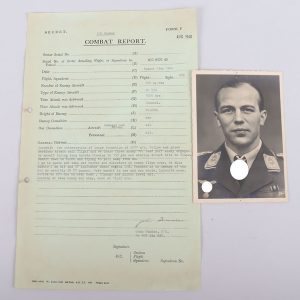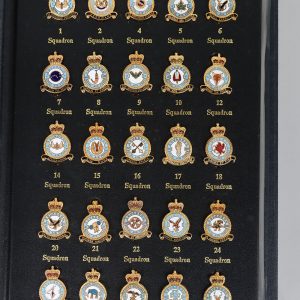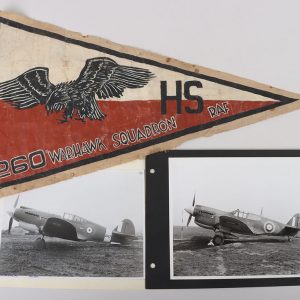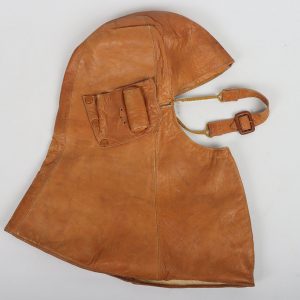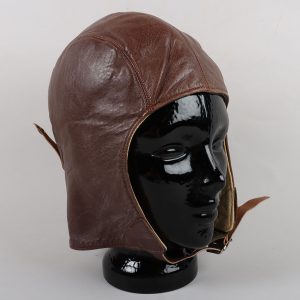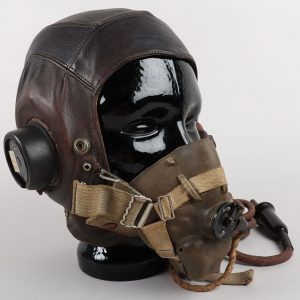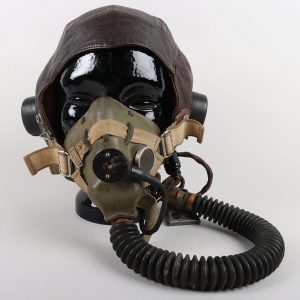Цены, указанные на сайте, могут быть изменены.
Для уточнения актуальных цен свяжитесь с нами или воспользуйтесь формой обратной связи.
Отображение 1–16 из 40
Фильтры-
#372 – Royal Air Force Far East Flight Commemorative Folio for the flight of Four Supermarie-Napier Southampton Flying Boats 1927-28 (Лот: 8964)
Ставки принимаются через менеджераRoyal Air Force Far East Flight Commemorative Folio for the flight of Four Supermarie-Napier Southampton Flying Boats 1927-28, folio published to commemorate the 1927-1928 flight of four Supermarine-Napier ‘Southampton’ flying boats which successfully flew from Felixstowe to Singapore, departing 27 October 1927 arriving 28 February 1928. Contains two folio pages which have extracts from the official log of the flights which were commanded by Group Captain H. M. Cave-Browne-Cave, D.S.O. D.F.C. Four colour plates which show the personnel of the RAF Far East flight (identified on the reverse), Four Supermarine-Napier ‘Southampton’s’ at the Singapore Air Base, Officers of the RAF Far East Flight with model of the aircraft in front of them (identified below) and a Supermarine-Napier ‘Southampton’ in flight between Akyab and Rangoon. Each measures 45 ½ x 32cms approx.
-
#373 – Nationally Important Gold Caterpillar Club Badge and Log Books of Air Vice Marshall Donald Bennett CB, CBE, DSO, Royal Air Force, Commander of the Pathfinder Force During WW2 (Лот: 8965)
Ставки принимаются через менеджераNationally Important Gold Caterpillar Club Badge and Log Books of Air Vice Marshall Donald Bennett CB, CBE, DSO, Royal Air Force, Commander of the Pathfinder Force During WW2, Caterpillar Club badge in gold with ruby eyes, reverse engraved ‘WC/CDR D C T BENNETT’. Brooch pin fitting to the reverse. Accompanying the badge are eight original Royal Air Force and Civilian Flying Log Books belonging to Bennett, the log books cover pre-war, wartime and post war period. The logs cover his time training with the RAF and also his time serving with the Imperial Airways. The most interesting from a wartime period is his civilian log book titled as ‘4’, this log has the entry on 27th April 1942, which states he was ‘Shot down low level attack on Tirpitz’ and the last entry in the log on 5th July 1942, ‘Appointed to Command Path Finder Force’. The logs are well filled out with many interesting details, including his involvement in the Berlin Airlift. eing sold by direct family descent of Air Vice Marshall Bennett. onald Bennett was born the youngest son of a grazier and business agent in Queensland, Australia. He attended Brisbane Grammar School. After some time working in his father’s business, he joined the Royal Australian Air Force in 1930, qualifying at RAAF Point Crook as a pilot. He transferred to the RAF a year later. Starting with the flying Boats of no 210 Squadron. Bennett developed a passion for accurate flying and precise navigation that would never leave him. After a period as an instructor, he left the service in 1935, retaining a reserve commission, to join Imperial Airways. Over the next five years, Bennett specialised in long-distance flights, breaking a number of records and pioneering techniques which would later become commonplace, notably air to air refuelling. In July 1938 he piloted the Mercury part of the Short Mayo Composite flying-boat across the Atlantic; this flight earned him the Oswald Watt Gold Medal for that year.uring 1940 Bennett was involved in setting up the Atlantic Ferry Crossing, bringing many aircraft over from the USA to the UK. In 1941 he was recommissioned into the Royal Air Force Volunteer Reserve as a Squadron Leader. Promoted to Wing Commander, he was posted to command No77 Squadron, as part of Bomber Command. In April 1942, No. 77 Squadron was transferred to Coastal Command and Bennett was given command of No. 10 Squadron (Handley Page Halifax) and shortly afterwards led a raid on the German battleship Tirpitz. Shot down during that raid, he evaded capture and escaped to Sweden, from where he was able to return to Britain; he and his copilot were awarded the Distinguished Service Order (DSO) on 16 June 1942. It was for this raid on the Tirpitz which resulted in the award of the Caterpillar Club badge. n July 1942, Bennett was appointed to command the new Pathfinder Force (PFF), an elite unit tasked with improving RAF Bomber Command’s navigation. At this stage of the war, Bomber Command had begun to make night-time raids deep into Germany, but had not yet been able to cause significant damage, largely because only about a quarter of the bomb loads were delivered “on target” — and this at a time when “on target” was defined as within three miles of the aim point. Bennett was called to Bomber Command HQ when he was on the point of leaving with his squadron for the Middle East. There he was informed by Sir Arthur Harris (Bomber Harris), that he was to lead a special force to make use of the new bombing and navigational aids then available and the more sophisticated ones that would follow. With effect from 5 July he was promoted to group captain. In 1943 Bennett was promoted with the upgrading of PFF to group status to air commodore, and then in December to acting air vice marshal, the youngest ever to hold that rank, giving him a rank similar to those of the other commanders of groups. He remained in command of the Pathfinder Force until the end of the war, overseeing its growth to an eventual 19 squadrons, a training flight and a meteorological flight, working relentlessly to improve its standards, and tirelessly campaigning for better equipment, in particular for more Mosquitos and Lancasters to replace the diverse assortment of often obsolete aircraft with which the force started.
-
#374 – WW2 Royal Canadian Air Force Flying Log Book of Warrant Officer G H Jenkins Navigator and Air Gunner with 415 & 524 Squadron (Лот: 8966)
Ставки принимаются через менеджераWW2 Royal Canadian Air Force Flying Log Book of Warrant Officer G H Jenkins Navigator and Air Gunner with 415 & 524 Squadron, the RCAF log book begins in 1943 when he began training on various aircraft. In June 1944 he was posted to No 415 Squadron flying in Wellington Bombers with Flight Lieutenant Meggison, he was the Navigator. In July 1944 he along with Flt Lt Meggison were moved to No 524 Squadron, still flying Wellington Bombers, they took part in operations over the Belgium and Dutch coasts. On the 27th July he notes ‘DOCKING – THORNEY ISLAND ‘W’ PATROL DIEPPE MANY ROBOT BOMBS SEEN – A NUMBER OBSERVED SHOT DOWN’. On August 11th 1944 he remarks on the fact they were chased by Night Figher. They continued on operations in the area throughout August, September and October, with various entries in the log book covering these missions and the various successes. On the 8th November 1944, during an armed reconnaissance mission they were shot up by a night fighter and 4 foot of their tail plane shot off. In December 1944 they were also attacked badly and it is noted in the log book that on the 5th December, the pilots escape hatch was blown off. In 1945 they continued with various operations, including against anti-midget submarines. The final operation was on the night of 3rd / 4th May 1945. Jenkins continued to serve into the immediate post war years with 86 Squadron. Further research accompanies the log book.
-
#375 – WW2 Royal Air Force 1945 Casualty Log Book of Flight Sergeant H W Parker 578 Squadron (Лот: 8967)
Ставки принимаются через менеджераWW2 Royal Air Force 1945 Casualty Log Book of Flight Sergeant H W Parker 578 Squadron, good Navigators and Air Gunners log book, he trained as a wireless operator air gunner. The logbook starts on 25th August 1943. In September 1944 he joined No 578 Squadron, flying on Halifax aircraft. His first operation was to Calais on 25th September, but this was called off by the master bomber. 30th October 1944 whilst on a mission to Cologne he notes ‘HIT BY FLAK IN M/U TURRET’ they made an emergency landing in Melbourne. The following month whilst on a mission to Julich he states, ‘HOLED IN STBD WING: COCKPIT & FUSELAGE BY FLAK’. On 20th February 1945 whilst on mission to Reinholz, he notes that their aircraft was attacked by fighter, two of the aircraft in his squadron were shot down during this operation. His last operation was on the night of 7th / 8th March 1945, when he and his crew were sent to attack Hemmingstedt, his and two other aircraft from his squadron failed to return and his log book has the note ‘Missing’, later with the ink stamp for ‘DEATH PERSUMED’ and signature of the Wing Commander commanding 578 Squadron. Research states that the aircraft was last heard calling for help on the wireless before crashing into the sea. The logbook is accompanied by comprehensive research. Flight Sergeant Harry William Parker is commemorated on the Runnymede Memorial, he was 20 years old at the time of his death. He was the son of Harry and Lilian Parker of Northfield, Birmingham.
-
#376 – Historically Interesting Photograph Album of No 81 Squadron 151st Wing RAF Mission to Soviet Russia in 1941 to Fly Operationally, Equip and Train Soviet Pilots on Hurricane Fighter Aircraft (Лот: 8968)
Ставки принимаются через менеджераHistorically Interesting Photograph Album of No 81 Squadron 151st Wing RAF Mission to Soviet Russia in 1941 to Fly Operationally, Equip and Train Soviet Pilots on Hurricane Fighter Aircraft, the album was compiled by Aircraftsman R Allen from Haywards Heath, Sussex. The photograph album, although small, has excellent photographs which detail this historic event in WW2. Many super images of the battle damage in the Soviet port where they were brought into, excellent images of Hurricane aircraft both in flight and on the ground in the snow. Many good images of RAF personnel and Soviet Russian airman etc. Some loose images and also a group of letters written by Allen to his parents. The album contains 50 photographs. Also accompanying the album is the book ‘Hurricanes Over Murmansk’ by John Golley. ollowing the German Invasion of the Soviet Union, it was decided to send a wing of Hawker Hurricane fighters to assist the Soviet war effort, and No. 81 Squadron reformed at RAF Leconfield on 29 July 1941 as part of No. 151 Wing RAF. In September it flew its Hurricanes off the carrier HMS Argus, deploying to an airfield near Murmansk. It flew both defensive sorties and escort missions for Soviet bombers, while carrying out its principal role of training Soviet pilots on the Hurricane. After a few weeks of operations the Hurricanes were handed over to the Soviets and the Squadron left to return to the UK at the end of November. ue to the very short time and small amount of men which were involved in this operation, very few personal snapshots exist of this event which makes this album a very historically important item.
-
#377 – Large Comprehensive Photograph Album of Official Photographs of Aircraft at Boscombe Down Airfield 1939-45, Compiled by Air Vice Marshall Bernard Francis McEntegart C.B, C.B.E (Лот: 8969)
Ставки принимаются через менеджераLarge Comprehensive Photograph Album of Official Photographs of Aircraft at Boscombe Down Airfield 1939-45, Compiled by Air Vice Marshall Bernard Francis McEntegart C.B, C.B.E, the album consists of 77 album pages, each with a official photograph of an aircraft from WW2. Including Lancaster bombers, Mosquito’s, Spitfires, Warwicks, Wellington bombers, Tempests, Typhoons, plus many more. The inside page of the album with inked details of aircraft. Front cover with the name of McEntegart when he was an Air Commadore, this inked out. A very comprehensive album with good official images of the majority of the aircraft used in WW2.
-
#378 – Two Framed and Glazed Picture Frames Relating to No10 Squadron RAF (Лот: 8970)
Ставки принимаются через менеджераTwo Framed and Glazed Picture Frames Relating to No10 Squadron RAF, consisting of black and white images of crews outside the Halifax bombers and one frame with illustrations from No 10 Squadron. Accompanied by 8 black and white press photographs of Handley Page Halifax II Bombers.
-
#380 – Royal Air Force Battle of Britain Day 15th September 1940 Typed Combat Report, Pilot Officer (Later Flying Officer) Eugene Tobin 609 Squadron Royal Air Force (Лот: 8972)
Ставки принимаются через менеджераRoyal Air Force Battle of Britain Day 15th September 1940 Typed Combat Report, Pilot Officer (Later Flying Officer) Eugene Tobin 609 Squadron Royal Air Force, the printed and typed green combat report document dated 15th September 1940, known as Battle of Britain day, detailing the attack by Tobin against various German aircraft who were sent to bomb London. The report gives the following details, ‘Vectored to attack large enemy formation bombing London docks. Grouped with fighters of 310 and 253 squadron. Together with F/O Dundas we noted a DO 17 trailing smoke with starboard engine feathered away from main formation. Both went in and fired a long burst of D/Wilde closing to approx 200 yds. Noted hits along port F/L as enemy rolled and dropped to 12,000 ft. Heavy smoke and well alight. Followed some three miles and enemy jetisioned bombs which fell in open country side. Decided to not close again as A/C nearly down. No crew seen to leave. Enemy forced landed in farmland. Circled twice but unable to see further activity. Fire appears to be in engine area. R/T for return to base. Enemy A/C possibly 2555. F1+FS. On my return to Base Middle Wallop coming in to land south of Field on approach run and in front at approx. 300 yds, I saw a fire tender with no B/O lights on strip. Full throttle and up but to close to him and unable to avoid. Clipped U/C port when and no response on D/unit so decided to put straight down as rev’s dropped. Heavy landing which pulled me in a 60 dog. Full account to be sent to C.O.’ Punch holes to the side of the document. Some light creases but generally still in good condition. lying Officer Eugene Tobin was born in Salt Lake City, Utah, USA. He learned to fly in the 1930’s. Originally he came to Europe to fight in the Finnish Soviet war, but this was over by the time he arrived. He wanted to serve against the German’s in France for the French Air Force, but again the German’s had already invaded France before he arrived. He and other Americans he travelled with joined the RAF in 1940. He flew during the Battle of Britain with 609 Squadron and was credited with two shared kills, the one from this combat report and another share of a Bf-110 on 25th August 1940. On 18th September 1940 he was posted to No71 Squadron ‘Eagle Squadron’. On the 7th September 1941, Tobin was killed in action when his Spitfire was shot down over Northern France. He crashed into a hillside near Boulogne-sur-Mer and was buried in Boulogne Eastern Cemetery. He was 24 at the age of his death.
-
#381 – Royal Air Force Battle of Britain Combat Report of Flying Officer John Dundas DFC & Bar 609 Squadron (Лот: 8973)
Ставки принимаются через менеджераRoyal Air Force Battle of Britain Combat Report of Flying Officer John Dundas DFC & Bar 609 Squadron, the printed and typed green combat report document dated 13th August 1940, detailing a combat by Dundas against a German Ju-87b over the English Channel, ‘Scramble for interception of large formation of JU87 a/c. Yellow and green sections attack main flight and we chase three enemy SW. Lead port enemy engaged by myself firing long bursts closing to 150 yds and scoring direct hits to flaps. Bandit down to 8,000 and trying to pull away from me. I go in again and take out rudder and elivators as enemy flips over. At this minute I am hit and SP indicator shows engine O/H. Unknown as to damage of who hit me possibly JU87 gunner. Note bandit in sea and one chute, Lulworth area. Decide on RTB due to over heat. T/gauge and glycol level out. Landing at base heavy but okay, down at 16.25 hrs.’ The document has ink signature of Dundas to the bottom of the document. Punch holes to the edge of the document. Fold lines but generally good condition. Accompanied by a WW2 German postcard photograph of Major Helmut Wick, who was Dundas last kill.John Charles Dundas DFC & Bar, was born in West Yorkshire in August 1915. He graduated from Christchurch college, Oxford. He became a journalist until joining the Royal Air Force in 1938. He joined 609 Squadron and was credited with shooting down 9 enemy aircraft before he was shot down and killed on 28th November 1940, after he had shot down Luftwaffe ace, Major Helmut Wick, believed Dundas was shot down by Wick’s wingman, straight after he scored the kill on Wick, both pilots aircrafts crashed into the English Channel and both pilots were declared lost. One of the Spitfires Dundas flew is on display at the Imperial War Museum.
-
#383 – Royal Air Force No 260 Squadron Pennant (Лот: 8975)
Ставки принимаются через менеджераRoyal Air Force No 260 Squadron Pennant, fine and unusual triangular pennant with painted emblem and colours of the squadron. Measures 50 x 31cms. Accompanied by two black and white official photographs of Curtiss P-40 Kittyhawk’s. he squadron originally formed at the end of WW1 as an anti-submarine unit. They disbanded in 1919 and was then reformed on 22nd November 1940 at RAF Castletown, Scotland and operated Hawker Hurricanes. It then moved to Egypt and operated Curtiss Kittyhawk fighter bombers over the western desert. The squadron then advanced with the Eighth Army into Tunisia. With the North African Campaign over it then moved to Sicily following Operation Husky. As the allied forces advanced into Italy it converted to the North American P-51 Mustang and it disbanded at Lavariano on 19 August 1945.
-
#384 – WW1 British Royal Flying Corps / Royal Air Force Cowl Pattern Hood Flying Helmet (Лот: 8976)
Ставки принимаются через менеджераWW1 British Royal Flying Corps / Royal Air Force Cowl Pattern Hood Flying Helmet, soft tan leather hood flying helmet with ear rolls, leather strap. Interior partially chamois lined, missing the wool interior lining to the hood. Crown with London tailors label. Some wear but still a good displayable item.
-
#385 – WW2 Royal Canadian Air Force (R.C.A.F) B-Type Flying Helmet (Лот: 8977)
Ставки принимаются через менеджераWW2 Royal Canadian Air Force (R.C.A.F) B-Type Flying Helmet, being a mint 1942 dated example of the light brown leather B-Type style flying helmet without ear cups or fittings as used for training pilots and aircrew. Helmet has all the original goggle strap fittings and rear fixing strap with buckle. Original chinstrap and buckle fitting. Mint condition chamois lining to the interior with clear manufactures stamp and date 1942. These helmets were also said to have been used by some S.O.E agents dropped into enemy territory.
-
#386 – WW2 Royal Air Force C-Type Flying Helmet Set (Лот: 8978)
Ставки принимаются через менеджераWW2 Royal Air Force C-Type Flying Helmet Set, good example of a brown leather C-Type flying helmet which is complete with the original headphones and wiring loom. Helmet has the leather goggle securing straps. Interior with chamois lining with remains of ink stampings. Helmet is accompanied by a original WW2 1945 dated H-Type Oxygen mask. Set shows some service wear with a small area of damage to the leather where the wiring loom connects to the earphone wires, but still displays well. Wartime H-Type masks are becoming very hard to find.
-
#387 – WW2 Royal Air Force C-Type Flying Helmet Set (Лот: 8979)
Ставки принимаются через менеджераWW2 Royal Air Force C-Type Flying Helmet Set, good example of a brown leather C-Type flying helmet which is complete with the original headphones and wiring loom (missing jack plug). Helmet has the leather goggle securing straps. Interior with chamois lining with remains of ink stampings. Helmet is accompanied by a Post WW2 (1953) dated H-Type Oxygen mask with the original rubber tube and metal crocodile clip to the bottom. Set shows some service wear but still displays well.
